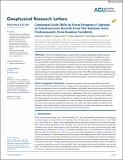Notice
This is not the latest version of this item. The latest version can be found at:https://dspace.mit.edu/handle/1721.1/133792.2
Centennial‐scale shifts in storm frequency captured in paleohurricane records from The Bahamas arise predominantly from random variability
Author(s)
Wallace, EJ; Coats, S; Emanuel, KA; Donnelly, JP
DownloadPublished version (1.891Mb)
Publisher with Creative Commons License
Publisher with Creative Commons License
Creative Commons Attribution
Terms of use
Metadata
Show full item recordAbstract
© 2020 The Authors. Event-based paleohurricane reconstructions of the last millennium indicate dramatic changes in the frequency of landfalling hurricanes on centennial timescales. It is difficult to assess whether the variability captured in these paleorecords is related to changing climate or randomness. We assess whether centennial-scale active and quiet intervals of intense hurricane activity occur in a set of synthetic storms run with boundary conditions from an earth system model simulation of the last millennium. We generate 1,000 pseudo sedimentary records for a site on South Andros Island using a Poisson random draw from this synthetic storm data set. We find that any single pseudo sedimentary record contains active and quiet intervals of hurricane activity. The 1,000-record ensemble average, which reflects the common signal of climate variability, does not. This suggests that the record of paleohurricane activity from The Bahamas reflects variability in hurricane frequency dominated by randomness and not variability in the climatic conditions.
Date issued
2021Journal
Geophysical Research Letters
Publisher
American Geophysical Union (AGU)